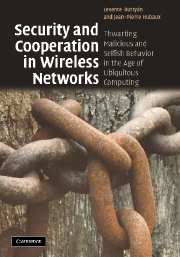 Security and Cooperation in Wireless Networks
Security and Cooperation in Wireless Networks Book contents
- Frontmatter
- Contents
- Preface
- Acknowledgements
- Part I Introduction
- Part II Thwarting malicious behavior
- 4 Naming and addressing
- 5 Establishment of security associations
- 6 Securing neighbor discovery
- 7 Secure routing in multi-hop wireless networks
- 8 Privacy protection
- Part III Thwarting selfish behavior
- Appendix A Introduction to cryptographic algorithms and protocols
- Appendix B A tutorial on game theory for wireless networks
- References
- Index
7 - Secure routing in multi-hop wireless networks
from Part II - Thwarting malicious behavior
Published online by Cambridge University Press: 05 June 2012
- Frontmatter
- Contents
- Preface
- Acknowledgements
- Part I Introduction
- Part II Thwarting malicious behavior
- 4 Naming and addressing
- 5 Establishment of security associations
- 6 Securing neighbor discovery
- 7 Secure routing in multi-hop wireless networks
- 8 Privacy protection
- Part III Thwarting selfish behavior
- Appendix A Introduction to cryptographic algorithms and protocols
- Appendix B A tutorial on game theory for wireless networks
- References
- Index
Summary
As we have described in Chapter 2, some of the upcoming wireless networks use multi-hop wireless communications. In those networks, the nodes have two roles: they act as end-systems and they also perform routing functions. This means that routing control messages are sent over wireless channels. Moreover, because of the lack of their physical protection, some of the routers could be corrupted and not follow the routing protocol faithfully. This can have undesirable effects on the operation of the network. In extreme cases, the operation of the entire network can be disabled by attacking the routers and manipulating the messages of the routing protocol. This chapter is devoted to this problem. More precisely, we study the problem of securing the routing protocol in two kinds of multi-hop wireless networks: mobile ad hoc networks and wireless sensor networks.
Routing protocols for mobile ad hoc networks
A large amount of work on routing in mobile ad hoc networks has been carried out in the research community, which has resulted in a multitude of routing protocols. One way to classify ad hoc network routing protocols is illustrated in Figure 7.1. As we can see, there exist topology-based routing protocols and position-based routing protocols. Topology-based protocols are based on traditional routing concepts, such as maintaining routing tables or distributing link-state information, but they are adapted to the special requirements of mobile ad hoc networks.
- Type
- Chapter
- Information
- Security and Cooperation in Wireless NetworksThwarting Malicious and Selfish Behavior in the Age of Ubiquitous Computing, pp. 169 - 236Publisher: Cambridge University PressPrint publication year: 2007


